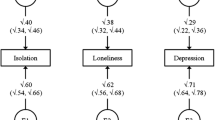Abstract
Background
Social isolation is associated with poor prognosis in schizophrenia. We aim to determine the effect of rural or urban residence on frequency of social and family contacts.
Method
We analysed data from the European Schizophrenia Cohort, a two-year follow-up study of 1,208 patients in Britain, France and Germany. Frequency of contact was elicited with Lehman’s Quality of Life Inventory. Between-effect error component regression models adjusted the effects of living environment for country, age, gender, education, schizophrenia symptoms and global functioning.
Results
Across all living conditions, contact with family occurred more frequently than contact with others. Family visits, social visits and planned social activities were less common in urban compared to rural settings, whereas no significant differences were found for social and family telephone calls and time spent with a spouse. Patients living with a partner had more family, but fewer social contacts, while women had more contact by phone. Family and social contacts across all categories decreased with age. Employment increased social contacts, but did not affect visits or phone calls within the family. Schizophrenia symptoms, particularly negative symptoms, and impaired global functioning decreased all aspects of social and family contacts.
Discussion
Contrasting with results of previous studies, we found rural living was associated with greater frequency of social contacts in patients suffering from schizophrenia. Beyond living environment, our findings stress the importance both of an adequate control of negative symptoms and of employment opportunities for schizophrenia patients in order to enhance their social networks.
Similar content being viewed by others
References
Angermeyer MC (1989) Soziales Netzwerk und Schizophrenie: Eine Übersicht [Social network and schizophrenia: an overview]. In: Angermeyer MC, Klusmann D (eds) Soziales Netzwer. Ein neues Konzept für die Psychiatrie [Social network. A new concept for psychiatry]. Springer, Berlin, Heidelberg, 188–206
Angermeyer MC, Roick C, Becker T, Kilian R (2004) Cost-effectiveness of Mental health service systems in the European comparison. In: Kirch W ed Public health in Europe. Springer, Berlin, 189–201
Bebbington PE, Angermeyer M, Azorin JM, Brugha T, Kilian R, Johnson S, et al. (2005) The European Schizophrenia Cohort (EuroSC)—a naturalistic prognostic and economic study Soc Psychiatry Psychiatr Epidemiol 40:707–717
Bengtsson-Tops A, Hansson L (2001) Quantitative and qualitative aspects of the social network in schizophrenic patients living in the community. Relationship to sociodemographic characteristics and clinical factors and subjective quality of life Int J Soc Psychiatry 47:67–77
Berkman LF (1995) Role of Social-Relations in Health Promotion Psychosom Med 57:245–254
Brummett BH, Barefoot JC, Siegler IC, Clapp-Channing NE, Lytle BL, Bosworth HB, et al. (2001) Characteristics of socially isolated patients with coronary artery disease who are at elevated risk for mortality Psychosom Med 63:267–272
Cohen CI, Kochanowicz N (1989) Schizophrenia and social network patterns—a survey of Black Inner-City Outpatients Community Ment Health J 25:197–207
Cohen CI, Sokolovsky J (1978) Schizophrenia and social networks—ex-patients in inner-city Schizophr Bull 4:546–560
Erickson DH, Beiser M, Iacono WG, Fleming JAE, Lin TY (1989) The Role of Social Relationships in the Course of 1St-Episode Schizophrenia and Affective Psychosis. Am J Psychiatry 146:1456–1461
Evert H, Harvey C, Trauer T, Herrman H (2003) The relationship between social networks and occupational and self-care functioning in people with psychosis Soc Psychiatry Psychiatr Epidemiol 38:180–188
Hamilton NG, Ponzoha CA, Cutler DL, Weigel RM (1989) Social networks and negative versus positive symptoms of Schizophrenia Schizophr Bull 15:625–633
Kay SR, Fiszbein A, Opler LA (1987) The Positive and Negative Syndrome Scale (Panss) for Schizophrenia. Schizophr Bull 13:261–276
Lehman AF (1983) The well-being of chronic mental-patients—assessing their quality of life. Arch Gen Psychiatry 40:369–373
Lehman AF, Kernan E, Postrado L (1996) Toolkit for evaluating quality of life for persons with severe mental illness. Human Services Research Institute, Cambridge, Mass
Norman RMG, Malla AK, Cortese L, Diaz F (1996) A study of the interrelationship between and comparative interrater reliability of the SAPS, SANS and PANSS. Schizophr Res 19:73–85
Paykel ES, Abbott R, Jenkins R, Brugha TS, Meltzer H (2000) Urban-rural mental health differences in Great Britain: findings from the National Morbidity Survey Psychol Med 30:269–280
Salokangas RKR (1997) Living situation, social network and outcome in schizophrenia: a five-year prospective follow-up study Acta Psychiatr Scand 96:459–468
Sörgaard KW, Hansson L, Heikkila J, Vinding HR, Bjarnason O, Bengtsson-Tops A, et al. (2001) Predictors of social relations in persons with schizophrenia living in the community: a Nordic multicentre study Soc Psychiatry Psychiatr Epidemiol 36:13–19
Thorup A, Petersen L, Jeppesen P, Ohlenschlaeger J, Christensen T, Krarup G, et al. (2006) Social network among young adults with first-episode schizophrenia spectrum disorders Soc Psychiatry Psychiatr Epidemiol 41:761–770
Wing JK, Babor T, Brugha T, Burke J, Cooper JE, Giel R, et al. (1990) Scan—schedules for clinical-assessment in neuropsychiatry. Arch Gen Psychiatry 47:589–593
Young J, De Geest S, Spirig R, Flepp M, Rickenbach M, Furrer H, et al. (2004) Stable partnership and progression to AIDS or death in HIV infected patients receiving highly active antiretroviral therapy: Swiss HIV cohort study Br Med J 328:15–18B
Author information
Authors and Affiliations
Corresponding author
Rights and permissions
About this article
Cite this article
Schomerus, G., Heider, D., Angermeyer, M.C. et al. Residential area and social contacts in schizophrenia. Soc Psychiat Epidemiol 42, 617–622 (2007). https://doi.org/10.1007/s00127-007-0220-1
Received:
Accepted:
Published:
Issue Date:
DOI: https://doi.org/10.1007/s00127-007-0220-1




